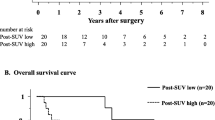Background and Purpose:
More effective preoperative treatment in locally advanced rectal cancer gives rise to a more individualized, conservative surgical treatment strategy. This, however, requires accurate information on tumor response after chemoradiation (CRT). So far, MRI and CT have failed to provide such information. Therefore, the value of a combined FDG-PET/CT in predicting tumor clearance of the mesorectal fascia (MRF) was determined.
Patients and Methods:
20 rectal cancer patients with MRF tumor invasion underwent preoperative PET/CT before and on average 6.3 weeks after CRT. The SUVmax(maximal standard uptake value) on sequential PET/CT and the shortest distance between the outlined tumor volume and the MRF measured by using autocontouring software on post-CRT PET/CT were registered. The surgical specimen was evaluated for tumor clearance of the MRF and the tumor regression grade (TRG).
Results:
The TRG significantly corresponded with the SUVmaxchanges induced by CRT (p = 0.025), and showed a trend with the post-CRT SUVmax(TRG 1–2 vs. TRG 3–5: SUVmax= 3.0 vs. 5.0; p = 0.06). However, the pathologically verified tumor clearance of the MRF was not correlated with any of the tested SUV parameters nor with the shortest distance between the residual tumor and the MRF.
Conclusion:
Post-CRT PET/CT is not a useful tool for evaluating anatomic tumor changes and, therefore, not accurate in predicting tumor clearance of the MRF. However, it might be a useful tool in predicting pathologic tumor response after CRT.
Hintergrund und Ziel:
Die immer effektivere präoperative Behandlung bei lokal fortgeschrittenem Rektumkarzinom verstärkt den Wunsch nach einer individuelleren, eher konservativen chirurgischen Behandlungsstrategie. Dies setzt jedoch exakte Informationen bezüglich der anatomischen Tumorantwort nach Radiochemotherapie voraus. In dieser Studie wurde der Wert der kombinierten FDG-PET/CT für die Vorhersage einer Tumorrückbildung an der mesorektalen Faszie (MRF) untersucht.
Patienten und Methodik:
20 Patienten mit Rektumkarzinom und MRT-bestätigter Tumorinvasion der MRF wurden präoperativ mit einer kombinierten FDG-PET/CT vor und im Mittel 6,3 Wochen nach Radiochemotherapie untersucht. Die Tumorvolumina wurden bei beiden PETs/CTs mit Hilfe einer Autokonturierungssoftware eingezeichnet. Der SUVmax(„maximal standard uptake value“) und der kürzeste Abstand zwischen dem eingezeichneten Tumorvolumen und der MRF wurden ermittelt. Das chirurgisch exzidierte Präparat wurde auf eine Tumorrückbildung an der mesorektalen Faszie und den Tumorregressionsgrad (TRG) untersucht.
Ergebnisse:
Der TRG korrespondierte signifikant mit den durch die Radiochemotherapie induzierten Veränderungen des SUVmax(p = 0,025) und annähernd signifikant mit dem SUVmaxnach Radiochemotherapie (TRG 1–2 vs. TRG 3–5: SUVmax= 3,0 vs. 5,0; p = 0,06). Es ließ sich jedoch keine Korrelation zwischen der pathologisch verifizierten Tumorrückbildung an der MRF und den untersuchten SUV-Parametern sowie dem kürzesten Abstand zwischen Resttumor und MRF feststellen.
Schlussfolgerung:
Diese Daten legen den Schluss nahe, dass eine wiederholte PET/CT-Untersuchung nach Radiochemotherapie beim Rektumkarzinom nicht in der Lage ist, anatomische Veränderungen so sicher zu ermitteln, dass eine konservativere operative Vorgehensweise zu verantworten wäre. Jedoch erweist sich die PET/CT als sinnvolle Untersuchung zur Vorhersage der pathologischen Tumorantwort nach Radiochemotherapie.
Similar content being viewed by others
Author information
Authors and Affiliations
Corresponding author
Rights and permissions
About this article
Cite this article
Vliegen, R.F.A., Beets-Tan, R.G., Vanhauten, B. et al. Can an FDG-PET/CT Predict Tumor Clearance of the Mesorectal Fascia after Preoperative Chemoradiation of Locally Advanced Rectal Cancer?. Strahlenther Onkol 184, 457–464 (2008). https://doi.org/10.1007/s00066-008-1858-7
Received:
Accepted:
Published:
Issue Date:
DOI: https://doi.org/10.1007/s00066-008-1858-7




